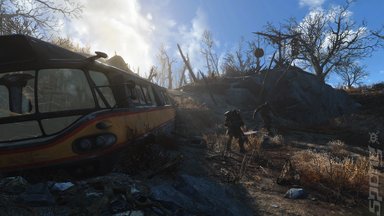Whilst there is some power to this depiction of the end of a civilisation, it’s rather too brief to have any real impact. Upon exiting the Vault, the player sees the burned skeletons of those who were left behind, but because there was no effort made to build any relationships with these NPCs prior to bombs being detonated, their fate does not have the resonance it could have had. More time spent in the pre-nuclear era, building friendships with those in the local neighbourhood, could have added an extra layer of pathos for the character as he emerges from the Vault and tries to make sense of the world that is left.
However, I am nit-picking here. Overall the story elements of the game work extremely well and later characters have a wonderful degree of depth. I struggle to remember the cast of Fallout 3, and there certainly wasn’t anyone as memorable as Nick Valentine.
Visually the game is solid, without being spectacular. Character models are, for this generation, rather basic and during the first few hours I really felt like I was still playing Fallout 3. However, the wasteland itself is exceptionally more detailed than earlier games and the sheer number of both enemies, allies and neutrals on screen during some encounters demonstrates the extent to which the game would not have been possible on earlier hardware.
Naturally, in a game of this size there are bugs. However, during my play-through, none of these were problematic to the extent that I was unable to complete objectives or enjoy the atmosphere and various story arcs. As with earlier games in the series it is worth using a number of save slots just in case problems do arise.
The wasteland of Fallout 3 and New Vegas was awash with junk. One of the key aspects of the game was sifting through the rubbish to find items that would be useful for survival. Fallout 4 takes this aspect of the game and greatly expands it. All items are now useful.
Throughout the wasteland, there are crafting stations that can be used to create or modify pretty much any material in the game. One of the key new elements of survival, the building of settlements, is achieved by scavenging items which can then be broken down into their component parts. These parts can then be used to create new items for the settlements. The range of items available for crafting is initially quite overwhelming.
Players aren’t given the option to simply ‘build house’, they must construct the walls, ceilings, furnish them and provide power, water and food supplies. Whilst this may sound like rather a lot of hard work, it is entirely optional. It is possible to play the entire game without improving any settlements.
However, for players who enjoy the prospect of crafting their own survival settlements, this aspect of the game provides a tremendous number of tools for this to be achieved. The crafting interface is, nevertheless, rather clunky and instructions for use are obscure. Bethesda has expertly taken an aspect of the Fallout universe, the accumulation of junk, and used it to add greater depth to the overall game.
It should come as no surprise that I would highly recommend Fallout 4, both to veterans of the previous games in the series and to newcomers. The pacing and bug problems that afflicted earlier games are largely absent here and the amount of content and addition of new gameplay mechanics is impressive. It is hard to know where to begin with Fallout 4, but that’s what makes it so compelling. I certainly won’t be leaving the wasteland for a long time.
Pros:
+ The wasteland is more detailed than ever.
+ Engaging stories.
+ Crafting system adds an extra layer of depth.
Cons:
- Glitches occasionally break the illusion.
- Sheer number of quests can sometimes be overwhelming.
- Some game systems could be better explained.
SPOnG Score: 9/10
However, I am nit-picking here. Overall the story elements of the game work extremely well and later characters have a wonderful degree of depth. I struggle to remember the cast of Fallout 3, and there certainly wasn’t anyone as memorable as Nick Valentine.
Visually the game is solid, without being spectacular. Character models are, for this generation, rather basic and during the first few hours I really felt like I was still playing Fallout 3. However, the wasteland itself is exceptionally more detailed than earlier games and the sheer number of both enemies, allies and neutrals on screen during some encounters demonstrates the extent to which the game would not have been possible on earlier hardware.
Naturally, in a game of this size there are bugs. However, during my play-through, none of these were problematic to the extent that I was unable to complete objectives or enjoy the atmosphere and various story arcs. As with earlier games in the series it is worth using a number of save slots just in case problems do arise.
The wasteland of Fallout 3 and New Vegas was awash with junk. One of the key aspects of the game was sifting through the rubbish to find items that would be useful for survival. Fallout 4 takes this aspect of the game and greatly expands it. All items are now useful.
Throughout the wasteland, there are crafting stations that can be used to create or modify pretty much any material in the game. One of the key new elements of survival, the building of settlements, is achieved by scavenging items which can then be broken down into their component parts. These parts can then be used to create new items for the settlements. The range of items available for crafting is initially quite overwhelming.
Players aren’t given the option to simply ‘build house’, they must construct the walls, ceilings, furnish them and provide power, water and food supplies. Whilst this may sound like rather a lot of hard work, it is entirely optional. It is possible to play the entire game without improving any settlements.
However, for players who enjoy the prospect of crafting their own survival settlements, this aspect of the game provides a tremendous number of tools for this to be achieved. The crafting interface is, nevertheless, rather clunky and instructions for use are obscure. Bethesda has expertly taken an aspect of the Fallout universe, the accumulation of junk, and used it to add greater depth to the overall game.
It should come as no surprise that I would highly recommend Fallout 4, both to veterans of the previous games in the series and to newcomers. The pacing and bug problems that afflicted earlier games are largely absent here and the amount of content and addition of new gameplay mechanics is impressive. It is hard to know where to begin with Fallout 4, but that’s what makes it so compelling. I certainly won’t be leaving the wasteland for a long time.
Pros:
+ The wasteland is more detailed than ever.
+ Engaging stories.
+ Crafting system adds an extra layer of depth.
Cons:
- Glitches occasionally break the illusion.
- Sheer number of quests can sometimes be overwhelming.
- Some game systems could be better explained.
SPOnG Score: 9/10




